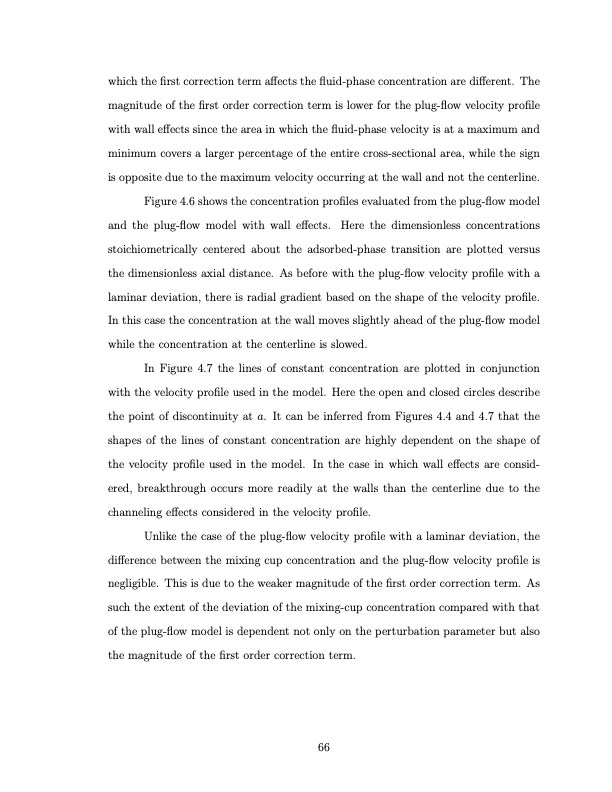
PDF Publication Title:
Text from PDF Page: 078
which the first correction term affects the fluid-phase concentration are different. The magnitude of the first order correction term is lower for the plug-flow velocity profile with wall effects since the area in which the fluid-phase velocity is at a maximum and minimum covers a larger percentage of the entire cross-sectional area, while the sign is opposite due to the maximum velocity occurring at the wall and not the centerline. Figure 4.6 shows the concentration profiles evaluated from the plug-flow model and the plug-flow model with wall effects. Here the dimensionless concentrations stoichiometrically centered about the adsorbed-phase transition are plotted versus the dimensionless axial distance. As before with the plug-flow velocity profile with a laminar deviation, there is radial gradient based on the shape of the velocity profile. In this case the concentration at the wall moves slightly ahead of the plug-flow model while the concentration at the centerline is slowed. In Figure 4.7 the lines of constant concentration are plotted in conjunction with the velocity profile used in the model. Here the open and closed circles describe the point of discontinuity at a. It can be inferred from Figures 4.4 and 4.7 that the shapes of the lines of constant concentration are highly dependent on the shape of the velocity profile used in the model. In the case in which wall effects are consid- ered, breakthrough occurs more readily at the walls than the centerline due to the channeling effects considered in the velocity profile. Unlike the case of the plug-flow velocity profile with a laminar deviation, the difference between the mixing cup concentration and the plug-flow velocity profile is negligible. This is due to the weaker magnitude of the first order correction term. As such the extent of the deviation of the mixing-cup concentration compared with that of the plug-flow model is dependent not only on the perturbation parameter but also the magnitude of the first order correction term. 66PDF Image | TEMPERATURE SWING ADSORPTION COMPRESSION AND MEMBRANE SEPARATIONS

PDF Search Title:
TEMPERATURE SWING ADSORPTION COMPRESSION AND MEMBRANE SEPARATIONSOriginal File Name Searched:
temp-swing-adsorption.pdfDIY PDF Search: Google It | Yahoo | Bing
CO2 Organic Rankine Cycle Experimenter Platform The supercritical CO2 phase change system is both a heat pump and organic rankine cycle which can be used for those purposes and as a supercritical extractor for advanced subcritical and supercritical extraction technology. Uses include producing nanoparticles, precious metal CO2 extraction, lithium battery recycling, and other applications... More Info
Heat Pumps CO2 ORC Heat Pump System Platform More Info
| CONTACT TEL: 608-238-6001 Email: greg@infinityturbine.com | RSS | AMP |